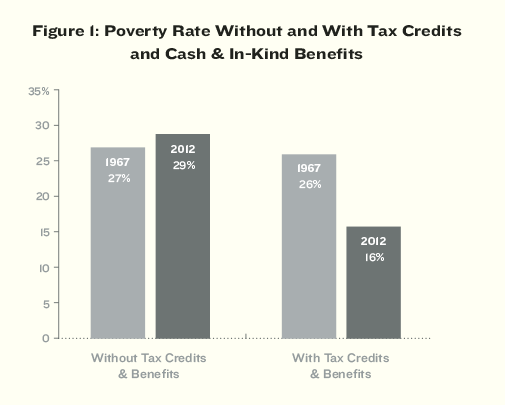A person is in poverty whenever the following is true of their income situation:
(Market Income + Transfer Income - Taxes) < Poverty Threshold
Thus, there are three ways to lift someone out of poverty:
- Increase their market income.
- Increase their transfer income
- Reduce their taxes.
Given that the poor do not pay much tax in the US, there are two basic channels for poverty reduction: market income or transfer income.
Due to various racist mechanisms, the market income channel presents Blacks with unique difficulties. The transfer income channel does not. Thus, it seems that anti-poverty strategies focused on transfer incomes are the most helpful to Black people and the most sensitive to the unique income challenges experienced by Black people. This is not to say that efforts shouldn't be made to deal with the market income obstacles. Obviously they should. It's just to say that, given that those obstacles currently exist, it's clear that anti-poverty strategies centered around market income are structurally biased against Black people and really all people who are structurally prevented from full labor market participation.
This is my pro-transfer take. But it's apparently not universally subscribed to. At Seven Scribes, Vann R. Newkirk II reaches the opposite conclusion about the racial dynamics of transfer programs:
[1.] While much of the safety net, save TANF, is not explicitly designed as such, the central conceit of anti-poverty programs is that a temporary injection of resources can help families rebound from poverty back above the threshold where they can pay for living unassisted again. Life above this threshold is generally considered some variation of lower-middle class. The logic checks out for poverty at large.
[2.] And the math checks out too. After Lyndon B. Johnson’s “War on Poverty” reforms, the national supplemental poverty rate–which takes into account a broader range of income as well as taxes and other expenses–decreased by an astonishing ten percentage points! This is good. Even as the age of inequality grips America, the basic assumptions of lifting people out of poverty–providing immediate living aid, health coverage, jobs, education, and housing–would probably do a decent job at it if we invested enough in it. For now at least.
[3.] But these proposals alone don’t quite work for black poverty. Black poverty is best understood as a societal-level phenomenon by which black people are in a sense predestined to poverty. Social mobility for white people is only loosely assortative; while the most poor white people and most wealthy white people are most likely to stay in their income ranges for life, there are good chances that people of any income range can wind up in another one. White children born in the middle three income quintiles can expect about a 25% lifetime chance of moving to another of the middle income ranges or even to the highest range. The only real rule here is that white people who aren’t born poor are unlikely candidates of ever becoming poor.
In paragraph one, Newkirk says that the purpose of transfer programs is to buffer you until you can get out of poverty by getting your market income to go up. In paragraph three (and elsewhere), Newkirk notes that Blacks face unique challenges in getting their market income to go up. Thus, he concludes that transfer programs don't really get the job done for Blacks.
But this argument is backwards. The purpose of transfer income is not to increase market income. These are separate income channels. By cramming the two channels together in the analytical way that he does, Newkirk uses the existence of racist barriers to market income mobility to take down all anti-poverty strategies, even transfer strategies that do not rely upon market income mobility to work.
The reason why Newkirk crammed transfer income and market income mechanisms together is explained by the text in paragraph two. In paragraph two, Newkirk claims that the Columbia Poverty Measure (CPM) confirms the point he made in paragraph one about the poverty-reducing nature of transfer income. But the CPM doesn't do that. In fact, it does the opposite.
Recall that Newkirk's theory of transfers is that they temporarily buffer you so that you can get out of poverty by increasing your market income. If this was the mechanism by which transfers cut poverty, then you would expect the War On Poverty reforms to have cut market poverty, i.e. poverty measured at the market distribution of income. But the CPM shows that this is not what happened. In fact, under the CPM, market poverty slightly increased over the period. The sole reason poverty fell was because higher transfers gave many populations with low market incomes enough extra income to put them over the poverty threshold. Put simply: the War On Poverty transfers worked by directly pushing people over the poverty line, not by indirectly boosting their market incomes.

So, contrary to Newkirk's argument, the CPM shows us that transfer incomes are perfectly capable of reducing poverty even without increasing upward market income mobility. Thus, the fact that Blacks face structural barriers to market income mobility is not an argument against the effectiveness of transfers for Blacks; rather, it's a very strong argument for the effectiveness of transfers for Blacks. Transfer-heavy approaches are more responsive to the nature of Black poverty precisely because poor Blacks face bigger market income mobility barriers than poor Whites do.